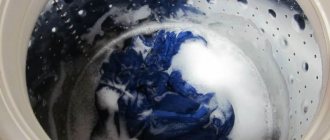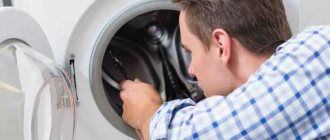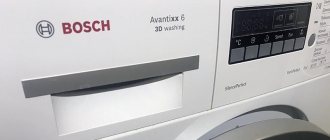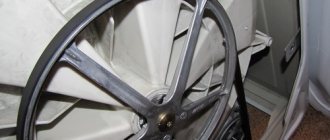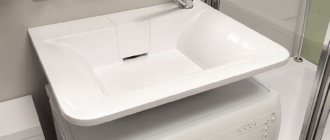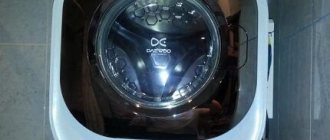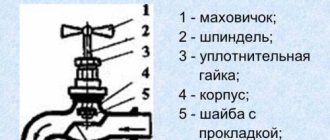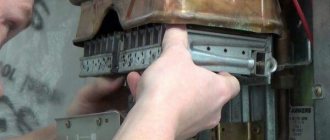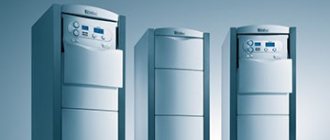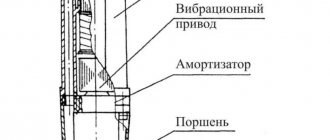An automatic washing machine (hereinafter also referred to as SM, SMA) is an indispensable assistant in almost every family. Therefore, its breakdown is perceived painfully by household members. One of the common problems is that the washing machine does not draw water or does so very slowly.
When the washing machine does not fill with water, it is impossible to wash
But there is no need to despair - in most cases, problems can be fixed on your own. Read more about this in our article.
Device design
Any washing machine consists of the following components:
- Frame. Protects internal equipment elements from damage.
- Drum. A moving part that allows the laundry to rotate during washing.
- Engine. The main force that rotates the drum.
- Tank. A container into which laundry is loaded.
- Pumps. Devices for filling the tank with water and removing excess moisture at the end of washing.
- Power block. Provides energy to the engine and electronic components of the system.
- Electronics. This includes the main control unit, sensors and switches for setting the operating mode of the machine.
Possible causes and solutions
| Probable Cause | Photo | How to check | How to fix |
| No flow or low pressure from the water supply | When you open the taps of the water supply system, water does not flow or flows weakly | Turn off the machine and wait for the problems in the plumbing system to be resolved | |
| Clogged inlet hose or inlet strainer | Disconnect the supply hose and filter, inspect them and blow them out | Clean the hose and filter from debris and rinse under running water. | |
| The side door is not closed tightly, the lock does not work | Check the tightness of the door, the condition of the locking mechanism and the fastening of the door hinges | Press the door firmly until the lock clicks. If necessary, clean the latching mechanism and tighten the hinges | |
| Damage to connecting wires or their insulation, oxidation of contacts | Inspect and test the internal electrical wiring with a tester for open circuits and short circuits. | Restore the integrity of electrical wires and their insulation, clean contacts | |
| The inlet (fill) valve does not work | Check the operation of the valve when 220V is applied to it. Inspect and test the valve windings, electrical wires and contacts with a tester | Restore the connecting wires, clean the contacts. Replace the faulty valve. | |
| The electric door lock is faulty | Test the blocker winding with a tester for open circuit and short circuit. Check the status of contacts | Clean contacts. Replace the faulty lock. | |
| The level sensor (pressure switch) is faulty | Check if the sensor receiving tube is clogged. Test the sensor and connecting wires with a tester for opens and short circuits. | Clear the sensor receiving tube of any accumulated debris. Replace faulty sensor. | |
| The software control module is faulty | The module does not receive control signals to trigger the machine components when they are working properly | Use a tester to check the receipt of control signals to individual nodes. Repair the module in a workshop or replace it with a working one. |
Most of these problems can be fixed on your own, but in some cases you cannot do without contacting a service workshop.
If you decide to carry out the repairs yourself, we offer the best range of spare parts for washing machines.
View all valves »
View all hatch locks »
View all pressure switches »
View all control modules »
Water supply
Water is supplied to the washing machine through special hoses connected to the water supply in the apartment. How long it takes to fill the tank depends on the equipment parameters. The system can be set to a certain level for washing.
The design also includes pressure monitors, which are small sealed containers with membranes at the inlet. As soon as the desired water level is reached, the pressure inside the container increases. The contact system allows you to close the valve, thereby stopping the flow.
Some machines use pressure sensors in the form of special electronic controllers created using semiconductor technology. In this case, increasing water level with increasing pressure changes the electrical conductive characteristics of the device. The received signal is sent to the control board.
The regulators protect the system from flooding, prevent the heating element from running dry, and also act as foam detectors.
Use of SMA
Now let's look at ways to use an automatic washing machine.
Manual method
Water is added manually to the detergent compartment. The main disadvantage of this method is that in order to continue working, the device must be independently added with water to the desired level. It should be taken into account that a modern washing machine adds rinsing water at least once.
Are you using citric acid?
Oh yes! No
If it is absent, the SMA will freeze or an error will appear. In other words, you need to be on duty next to a bucket of water so that the process ends correctly.
Additional tank
To create pressure in the system, place a reservoir of liquid 6-8 meters away from the washing machine. This option is possible if there is a second floor. The disadvantage of this method is the need to carry water to refill the tank.
Washing machines with an additional tank are sold. The most famous manufacturer is Slovenian. It produces SMA, especially for rural areas where there are no high-pressure water pipes.
sma with additional tank
Perhaps the most optimal solution for a dacha and village. In principle, you can make a tank yourself. You just need to place it above the machine to create the required pressure. In this case, you can purchase any car, not necessarily Gorenje.
Well
If there is already a well at your summer cottage, you will only need to install a powerful pumping station for uninterrupted operation. In another case, you can call a drilling team. But there are several factors to consider:
- Cost of equipment rental and team work.
- Drilling should be carried out in the summer.
- Water must be of good quality. If the quality is poor, the clothes may not wash at all.
Do you wash by hand?
Oh yes! No
Water heating
As soon as the tank of the machine is filled, a special control board activates the heating element, represented by a traditional tubular heating element system. The element increases the temperature of the water until the thermistor signals that heating has stopped.
Thus, three devices are involved in the process of heating water: a control board, a thermistor and a heating element. If at least one of the elements stops working correctly, errors will occur. The water may remain cold for the entire wash cycle or, on the contrary, heat up to very high temperatures or even boil.
Pump application
It is also possible to install a system consisting of an electric pressure pump and a water tank (for example, a barrel). This method is optimal in terms of cost and efficiency.
The pump will move liquid under pressure from the reservoir into the apparatus compartment. But without automation, you need to turn the pump on and off manually, while simultaneously monitoring the water level in the machine.
Pump application
Required spare parts for manufacturing the system:
- Pumping device.
- A barrel or other container for liquid.
- Set of gaskets and clamps.
- Set of flow filters.
- Silicone based sealant.
- A couple of meters of hose for the pipeline.
- A tee valve for shutting off the flow of water from the tank.
- Tools for measurements and installation.
- To automate the washing process, you will also need either an electromagnetic relay or reed switches.
Expert opinion
I work in the household appliance repair industry. Extensive experience in restoring washing machines and dishwashers.
Ask a Question
For greater compatibility, it is advisable to buy a pump of the same brand as the washing machine itself. A lid is also required to protect against accidental splashes.
Let's consider assembling the pumping system and connecting it to the washing machine:
- Let's choose a place to install the device. A flat, concrete surface if possible is required; the socket must be within reach of the wire.
- Place a container of the required volume nearby, preferably with a lid for convenience.
Do you wash your shoes in the machine?Oh yes! No
- To improve performance, you can make a stand for a barrel, about a meter high.
- Make a hole of the required diameter on the bottom wall of the tank for a tee tap and fix it.
- Connect the pressure hose to the tap, and connect the other end to the pump.
- Using an adapter, attach the discharge hose to the inlet hose of the washing machine.
Now you need to remove the top cover of the machine and find the solenoid valve. Let's remove the seals from it to improve water flow and install a flow filter in front of it. All that remains is to test the operation of the system.
Washing process
After loading the laundry into the inside of the washing machine, you need to close the hatch, and then select the desired washing program using the buttons and controls. As soon as the user starts the machine, the machine will lock the hatch and start washing.
Washing steps briefly:
- Engine starting. The motor speed is adjusted using a built-in tachometer. Detergent is placed from the powder container into the main chamber of the machine. At the same moment, the tank is filled with cold water, the volume of which is determined by the selected washing program. This stage involves soaking the laundry.
- Turning on the heating element. The heating of this element is also adjusted using a special sensor. The washing parameters are selected automatically after the user has selected the desired mode using the controls.
- Draining. The machine automatically signals the pump, which turns on the spin function. The pressure switch signals the absence of water in the tank, thereby activating the dial system and starting the rinsing procedure.
- Removing water after rinsing. A spinning procedure is immediately carried out, which is repeated several times.
- Final spin of laundry while rotating at high speeds. Simultaneously with the spin cycle, water is completely pumped out of the tank. Then a signal indicating the completion of the wash is sent to the control board. The hatch will unlock.
The presented algorithm helps to understand how any washing machine works. Almost all modern models operate on the same principle with minor differences.
Subscribe to TechnoCouncil on social networks so you don’t miss anything:
Principle of operation
The description of the structure of a drum-type washing machine and the procedure for performing operations to obtain clean laundry make it possible to formulate the principles of its operation:
- The process consists of the mechanical action of the drum on the laundry. Elements such as ribs, together with a perforated surface, when rotated, create manipulations similar to washing by hand.
- Possibility to wash clothes from almost any material. The control unit allows you to select a program for the most delicate fabric (delicate wash, hand wash, etc.).
- A wide range of temperatures used (30°C—95°C) in combination with proprietary powder makes it possible to obtain high-quality laundry.
- The drum volume allows you to load a fairly large number of dirty items at a time, increasing productivity.
